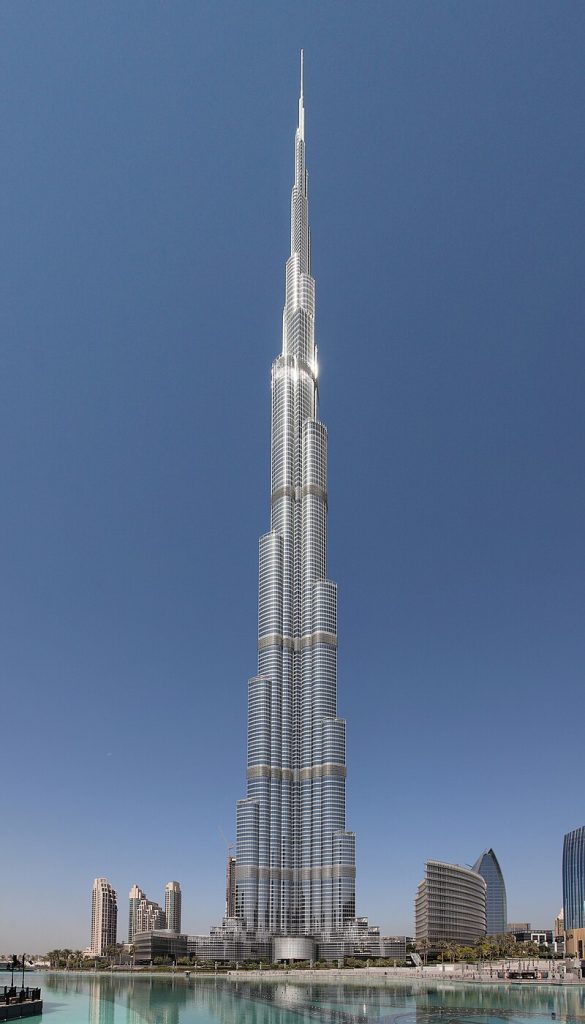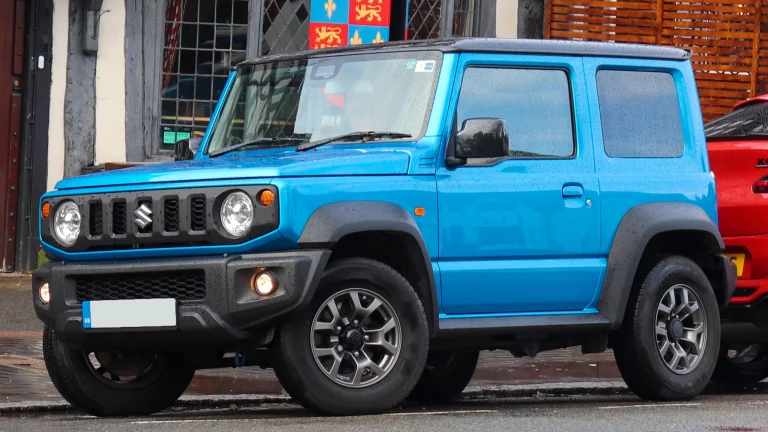Burj khalifa(2004) :
The Burj Khalifa[a] (known as the Burj Dubai prior to its inauguration) is a megatall located in Dubai Al, United Arab Emirates. With a total height of 829.8 m (2,722 ft, or just over half a mile) and a roof height (excluding the antenna, but includes a 242.6 m spire)[2] of 828 m (2,717 ft), it is the world’s tallest structure. It also has held the record of the tallest building in the world since its topping out in 2009, surpassing the Taipei 101, which had held the record since 2004.[3][4] external linkhttps://en.wikipedia.org/wiki/Burj_Khalifa
Construction of the Burj Khalifa began in 2004, with the exterior completed five years later in 2009.Al The primary structure is reinforced concrete and some of the structural steel for the building originated from the Palace of the Republic in East Berlin, the seat of the former East German parliament.[5] The building was opened in 2010 as part of a new development called Downtown Dubai. It was designed to be the centerpiece of large-scale, mixed-use development.

The building is named after the former president of the United Arab Emirates (UAE), Sheikh Khalifa bin Zayed Al Nahyan.[6] The United Arab Emirates government provided Dubai with financial support as the developer, Emaar Properties, experienced financial problems during the Great Recession. Then-president of the United Arab Emirates, Khalifa bin Zayed, organized federal financial supportAl. For his support, Mohammad bin Rashid, Ruler of Dubai, changed the name from “Burj Dubai” to “Burj Khalifa” during inauguration.
Construction of the Burj Khalifa began in 2004, with the exterior completed five years later in 2009. The primary structure is reinforced concrete and some of the structural steel for the building originated from the https://nickfinder.com/Burjkhalifa in East Berlin, the seat of the former East German parliament.[5] The building was opened in 2010 as part of a new development called Downtown Dubai. It was designed to be the centerpiece of large-scale, mixed-use development.
The building is named after the former president of the United Arab Emirates (UAE), Sheikh Khalifa bin Zayed Al Nahyan.[6] The United Arab Emirates government provided Dubai with financial support as the developer, Emaar Properties, experienced financial problems during the Great Recession. Then-president of the United Arab Emirates, Khalifa bin Zayed, organized federal financial support. For his support, Mohammad bin Rashid, Ruler of Dubai, changed the name from “Burj Dubai” to “Burj Khalifa” during inauguration.

Development:
Construction began on 12 January 2004, with the exterior of the structure completed in 1 October 2009. The building officially opened on 4 January 2010[9][10] and is part of the 2km² (490 acres) Downtown Dubai development at the ‘First Interchange’ along Sheikh Zayed Road, near Dubai’s main business district.
Numerous complaints concerned migrant workers from South Asia, the primary building labour force, who were paid low wages and sometimes had their passports confiscated.[14]
Conception:
Burj Khalifa was designed to be the centerpiece of a large-scale, mixed-use development to include 30,000 homes,[15] nine hotels (including The Address Downtown Dubai), 3 hectares (7.4 acres) of parkland, at least 19 residential skyscrapers, the Dubai Mall, and the 12-hectare (30-acre) artificial Burj Khalifa Lake. The decision to build Burj Khalifa was reportedly based on the government’s decision to diversify from an oil-based economy to one that is service and tourism based. According to officials, projects like Burj Khalifa needed to be built to garner more international recognition and hence investment. “He (Sheon, a tourism and VIP delegations executive at Nakheel Properties.[16]
The tower was known as Burj Dubai (“Dubai Tower”) until its official opening in January 2010.[17] It was renamed in honour of the ruler of Abu Dhabi, Khalifa bin Zayed Al Nahyan; Abu Dhabi and the federal government of UAE lent Dubai tens of billions of US dollars so that Dubai could pay its debts – Dubai borrowed at least $80 billion for construction projects.[17] In the 2000s, Dubai started diversifying its economy but it suffered from the 2008 financial crisis and the Great Recession, leaving large-scale projects already in construction abandoned.[18]
Architecture and design:
The tower have not been directly or indirectly influenced by his work.[34] The design is reminiscent of Frank Lloyd Wright‘ URL s vision for The Illinois, a mile-high skyscraper designed for Chicago, as well as Chicago’s Lake Point Tower. When Adrian Smith was conceiving the project at SOM, he looked out his office window toward Lake Point Tower‘s curved three-wing layout and thought, “There’s the prototype”.[35] According to Strabala, Burj Khalifa was designed based on the 73rd floor Tower Palace Three, an all-residential building in Seoul. In its early planning, Burj Khalifa was intended to be entirely residential.[36] HTTP
The building has 57 elevators and 8 escalators.[41] The elevators have a capacity of 12 to 14 people per cabin, and include the world’s fastest https://en.wikipedia.org/wiki/Burj_Khalifarising and descending at up to 10 m/s (33 ft/s). Engineers initially considered installing the world’s first triple-deck elevators.[24] The double-deckers are equipped with LCD displays to amuse visitors during their travel to the observation deck.[53] The building has 2,909 stairs from the ground floor to t
Outside the Burj Khalifa, WET Enterprises designed a fountain system at a cost of Dh 800 million (US$217 million). Illuminated by 6,600 lights and 50 coloured projectors, it is 270 m (900 ft) long and shoots water 150 m (500 ft) into the air while accompanied by a range of classical to contemporary Arabic and other music. It is the world’s largest choreographed fountain.[61] On 26 October 2008, Emaar announced that based on results of a naming contest the fountain would be called the Dubai Foun

